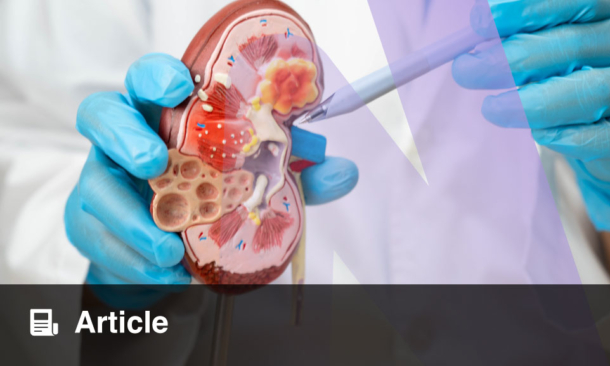Abstract
This case highlights an unusual presentation for infective endocarditis (IE). The patient was initially admitted with symptoms indicative of a urinary tract infection, with a concerning and unexplained symptom of significant weight loss. As per local hospital protocol, intravenous antibiotics were initiated to treat the urinary tract infection. However, due to the patient’s persistent and unexplained weight loss, further investigations were recommended, including a CT scan of the thorax, abdomen, and pelvis to rule out malignancy or deep-seated infections. The CT scan revealed splenic infarction, prompting an echocardiogram, which subsequently showed vegetation on the aortic and mitral valves, confirming IE.
Treatment for IE was promptly initiated, and a transoesophageal echocardiogram was performed. The patient underwent open-heart surgery to replace the aortic valve and repair the mitral valve. Post-surgery, the patient made an excellent recovery.
Key takeaway: this case underscores the importance of maintaining a high index of suspicion, as the symptoms of IE are often nonspecific, vary widely, and can develop insidiously. Endocarditis should be considered as a differential diagnosis, particularly in patients with fever and no obvious source of infection. This case illustrates how a rare and unusual presentation of IE can be diagnosed with timely intervention, leading to a favourable outcome.
Key Points
1. The clinical manifestations of infective endocarditis can vary widely, and often present with subtle or nonspecific symptoms.2. A high index of suspicion is essential for the accurate diagnosis of infective endocarditis.
3. Early diagnosis and prompt management are crucial, as they significantly improve prognosis and patient outcomes.
INTRODUCTION
Infective endocarditis (IE) often presents in an unusual and vague manner, especially in its early stages, where symptoms can be nonspecific. This case was initially presented as a urinary tract infection (UTI), but later revealed underlying IE.
In the case presented in this article, the key concerning symptom during presentation was unexplained weight loss, which prompted further investigation. The vague and unclear history raised suspicions, ultimately leading to a more thorough workup and the correct diagnosis of IE.
This case emphasises the importance of considering a broader differential diagnosis, particularly when the clinical presentation is ambiguous.
PATIENT INFORMATION
A 65-year-old White male patient, who had resided in Ireland for over 10 years and lived with his teenage son. His immediate family remain in his home country, and his next of kin is a close friend. The patient was not employed at the time of admission, and had a history of alcohol abuse, with a daily consumption of a bottle of vodka.
CLINICAL FINDINGS
A 65-year-old male patient presented to the emergency department after being bought in by an ambulance from home. He reported a history of nonspecific symptoms, including generalised weakness, fatigue, and low energy. He denied any recent flu-like symptoms, cough, shortness of breath, cardiac symptoms, gastrointestinal complaints, or neurological issues. The patient did note increased urinary frequency and dysuria. He had experienced intermittent fever for the past 2 days, along with occasional night sweats and unquantified weight loss, as he had not weighed himself. His symptoms had started 3 months prior to presentation, but had worsened in the preceding 2 weeks.
Notably, the patient did not have a general practitioner and had not had any recent or prior hospital visits.
Upon presentation, the patient’s vital signs were recorded as follows: blood pressure of 144/72 mmHg, pulse of 124 bpm, respiratory rate of 28 breaths/min, oxygen saturation of 96% on room air, temperature of 37.8°C, and a Glasgow Coma Scale (GCS) score of 15/15.
Physical examination revealed an elevated jugular venous pressure, but otherwise, the head and neck were unremarkable. The chest examination revealed no abnormalities, and the cardiac examination was normal, with no murmurs detected. The abdominal examination was also normal, with no tenderness or organomegaly. The general examination revealed no limb oedema, changes in fingers or toes, or palpable lymph nodes.
TIMELINE
Day 1:
The patient was admitted to the emergency department with a suspicion of UTI based on his symptoms and investigation findings. His weight loss, along with his history of alcohol abuse, raised concerns. Intravenous antibiotics were started as per hospital protocol, and further investigations were planned.
Day 2:
The patient was reassessed by the admitting team, and daily blood tests were scheduled to monitor his inflammatory markers and trace his urine culture results. A CT scan (thorax-abdomen-pelvis) was advised to investigate the cause of his weight loss, particularly to rule out malignancy or deep-seated infection.
Day 3:
The CT scan revealed a splenic infarction, prompting further investigations. An urgent echocardiogram (ECHO) was ordered, which revealed large vegetations on both the aortic and mitral valves. Infective endocarditis was diagnosed, and the patient was started on intravenous vancomycin and gentamicin. The case was discussed with the cardiology and microbiology teams, who confirmed the management plan. The patient was also observed to have a new soft diastolic murmur and macular rashes on his trunk and left foot, which were not present initially. His poor dental hygiene was noted as a potential source of infection. A CT brain was urgently performed, revealing subacute infarction in the left cerebellum, which added urgency to his management.
Day 4:
The patient underwent a transoesophageal echocardiogram (TOE), which confirmed severe aortic and mitral regurgitation, and large vegetations on both valves. He started on telemetry for monitoring. During the night, the patient developed a broad complex tachycardia, which was managed with intravenous magnesium sulfate.
The case was urgently discussed with the cardiothoracic team, and the patient was accepted for immediate surgery. Blood was cross-matched, and a full blood workup was performed. The patient was transferred to the operating theater for urgent aortic valve replacement and mitral valve repair.
DIAGNOSTIC ASSESSMENT
Blood Cultures
Both bottles of blood cultures flagged positive within 1 day: bottle A flagged positive for Gram-positive cocci in chains resembling Streptococcus spp., and in clusters resembling Staphylococcus spp., while bottle B flagged positive for Gram-positive cocci in chains resembling Streptococcus spp.
Culture Results
Both Staphylococcus hominis and Streptococcus oralis were sensitive to ceftriaxone and vancomycin.
Urine Analysis and Culture (Emergency Department)
- Red cells: >200/µL
- White cells: 27/µL
- Culture: No growth
Full Blood Count on Presentation
- Leukocytic Count: 14.89×109/L (high)
- Neutrophils: 12.63×109/L (high)
- Platelets: 72×109/L (low)
- Haemoglobin: 9.7 g/dL (low)
Biochemistry Results on Presentation
- Urea: 5 mmol/L
- Creatinine: 65 µmol/L
- C-reactive protein: 65.7 mg/L (high)
- Aspartate aminotransferase:47 U/L (high)
- Alanine Aminotransferase: 18 U/L
- Lactate Dehydrogenase: 427 U/L (high)
- Corrected Calcium: 2.25 mmol/L
- Phosphorus: 1 mmol/L
- Magnesium: 0.78 mmol/L
CT Scan (Thorax, Abdomen, and Pelvis)
There was no evidence of malignancy. Wedge-shaped low attenuation areas were noted in the anterior and posterior aspects of the spleen, indicative of splenic infarcts. Dilatation of both ureters to the vesicoureteral junctions was seen, as well as bilateral prominence of the renal calyces.
CT Brain
Multiple cortico-subcortical hypoattenuating foci in the left cerebellum were identified, suggesting acute to subacute infarcts. No space-occupying lesions, bleeding, orother abnormalities were seen.
Initial Echocardiogram Report
Study Indications: Referred for evaluation of bacterial endocarditis.
There was a sinus rhythm on the ECG, and the patient’s heart rate was 99 bpm.
Study Quality
This was a technically difficult study with suboptimal views.
Left ventricle and right ventricle
The left ventricle was markedly dilated, and mild septal hypertrophy was noted. The overall left ventricular systolic function was normal, with an ejection fraction of >55%, and diastolic dysfunction was indeterminate. The right ventricle was normal in size and function.
Left atrium and right atrium
The left and right atrium were normal in size and function.
Aortic valve
The aortic valve appeared tri-leaflet and was mildly thickened. There was at least moderate aortic regurgitation with turbulent flow, as well as mild aortic stenosis with a peak/mean pressure gradient of 46.00 mmHg/25.38 mmHg. The aortic valve area had a large vegetation.
Mitral valve
Mitral inflow was unable to be measured due to turbulent mitral regurgitation. Moderate mitral regurgitation (a posteriorly directed jet) was present. Evidence of a medium-sized mobile mass (a vegetation) attached to the anterior mitral valve leaflet.
Tricuspid valve
There was mild tricuspid regurgitation. The right ventricular systolic pressure, as measured by Doppler, was 32 mmHg + right atrial pressure.
Pulmonary valve
The pulmonary valve was not well visualised.
Pericardium
Trivial pericardial effusion was present, and there was no evidence of cardiac tamponade.
Aorta
The aortic root and ascending aorta were notably dilated, measuring up to 4.7 cm.
Inferior vena cava/hepatic veins
The inferior vena cava was normal.
Report summary
The report was relied upon immediately by the treating consultant.
Post-OperativeEchocardiogram Findings
There was a sinus rhythm on the ECG. The study was technically adequate.
Left ventricle and right ventricle
The left ventricle size was normal, but there was mild concentric left ventricular hypertrophy. The overall left ventricular systolic function was normal, with an ejection fraction of >55%, and the diastolic filling pattern indicated impaired relaxation. The right ventricle was normal in size and the right ventricular systolic function was normal.
Left atrium and right atrium
The right atrium was normal in size and function, and the left atrium was dilated.
Aortic valve
There was no evidence of aortic regurgitation, and the maximum pressure gradient across the aortic valve was 17.16 mmHg. Aortic valve replacement appeared well seated. Turbulent flow was noted at the left ventricular outflow tract, and there was no evidence of paravalvular leaks.
Mitral valve
The mitral valve was thickened with myxomatous degeneration, and the anterior leaflet appeared calcified. Turbulent flow was noted; however, no significant mitral regurgitation was observed.
Tricuspid valve
The tricuspid valve appeared structurally normal. There was trace/mild (physiologic) tricuspid regurgitation.
Aorta
The ascending aorta was dilated, measuring up to 4.4 cm. An aortic aneurysm was noted at the aortic arch.
Cardiac physiologist observations
All findings need to be clinically correlated.
THERAPEUTIC INTERVENTION
Initial management of the patient was admission on intravenous antibiotics and intravenous fluids. As the findings of IE came to the surface, the patient was started on intravenous vancomycin and gentamicin. Open-heart surgery to replace the aortic valve and repair the mitral valve was the main intervention this patient received. Antibiotic treatment (ceftriaxone) was continued for 6 weeks as percardiothoracic advice.
FOLLOW-UP AND OUTCOMES (1 MONTH AFTER SURGERY)
The patient was discharged and transferred back to the authors’ local hospital following his surgery. He made an excellent recovery, with his surgical wounds fully healed. He was on intravenous antibiotics for 6 weeks as per the cardiothoracic and microbiology teams’ recommendations. Upon discharge, he was seen by the cardiology team for a follow-up, and future appointments were scheduled for echocardiography and routine check-ups. The patient’s weight stabilised, and the rashes and murmur resolved. His cognitive function remained intact, and he was able to resume a more normal routine following a period of rehabilitation.
DISCUSSION
IE is an uncommon but potentially life-threatening condition that can present with a wide range of nonspecific symptoms. The clinical manifestations of IE vary from rapidly progressive acute infections to subacute or chronic forms with mild, constitutional symptoms.1 Early diagnosis requires a high level of suspicion, particularly when the presentation is vague, as was the case with the author’s patient. Due to the nonspecific nature of the symptoms, it is important to consider several differential diagnoses that can mimic the clinical features of IE.2 Major conditions to consider include systemic infections such as sepsis, bacterial pneumonia, or deep tissue abscesses, which can present with fever, weight loss, and vague systemic signs. Systemic lupus erythematosus can also present with similar symptoms and valvular lesions (Libman-Sacks endocarditis), but it is distinguished by the absence of positive blood cultures and the presence of autoantibodies. Rheumatic fever can present with carditis, but the history of a recent streptococcal throat infection and migratory arthritis can help to differentiate it. Malignancy, especially metastatic disease to the spleen, can cause weight loss, fever, and organ dysfunction, but it is not associated with positive blood cultures or vegetations. Pulmonary embolism can present with shortness of breath or chest pain, but it lacks typical echocardiographic findings. Lastly, splenic infarction from conditions like sickle cell disease or vasculitis may look similar, but positive blood cultures and echocardiographic findings of vegetations help confirm the diagnosis of IE.
In many cases, IE is associated with a primary source of infection such as dental and skin infections, or intravenous drug use. Interestingly, Aerococcus urinae, a rare pathogen typically associated with UTIs, can also cause IE, particularly in elderly patients with comorbid conditions such as diabetes or alcohol abuse. A study by Melnick et al.3 highlights A. urinae as an uncommon, yet important pathogen in the aetiology of IE, emphasising its unexpected role in UTI cases that progress to endocarditis.8 This finding underscores the importance of considering rare microorganisms when managing patients with UTI symptoms and unexplained complications.
The author’s case further supports the notion that a high index of suspicion is critical when diagnosing IE, especially in patients who exhibit nonspecific symptoms. In this case, the patient’s unexplained weight loss prompted further investigation and resulted in the discovery of splenic infarction, which led to a TOE that revealed significant vegetations on both the aortic and mitral valves. This was highlighted in another case report of a middle-aged male who presented to the emergency department with complaints of excessive weight loss.4 An additional learning point from the author’s case is the importance of conducting a thorough cardiac examination. Although the patient had no murmurs, 85% of cases will have a new or changing cardiac murmur.1 Previous case reports, such as a 51-year-old male who presented with confusion as a sign of IE,5 and a 52-year-old male who presented with weight loss,4 have highlighted the atypical presentations of this condition. In these cases, confusion and weight loss were key symptoms that led to the eventual diagnosis. These cases, along with the author’s case, demonstrate that endocarditis can often present with subtle or unusual symptoms, making early recognition crucial for optimal outcomes.
Interestingly, in the author’s case, the patient’s poor oral hygiene was identified as a possible source of the infection. As noted in previous literature, dental infections are a well-known risk factor for IE, and patients with poor oral hygiene are at a higher risk.6 In this case, the patient’s dental health was addressed by the maxillofacial team, who extracted all of the patient’s teeth to help prevent further complications.
The role of echocardiography in diagnosing IE is paramount. As outlined in the 2023 Duke-International Society for Cardiovascular Infectious Diseases (ISCVID) criteria for endocarditis, echocardiographies and blood cultures are key diagnostic tools.7 The criteria incorporate major components such as positive blood cultures and echocardiographic evidence of vegetations or abscesses, along with minor criteria like predisposing conditions, fever, and vascular or immunologic phenomena. TOE is particularly useful in detecting vegetations in cases where the diagnosis is not immediately apparent from initial examinations.
In the author’s case, TOE confirmed the presence of large vegetations on both the aortic and mitral valves, which contributed to the diagnosis under the Duke criteria, ultimately leading to urgent surgical intervention. The criteria can be easily calculated using online medical calculators, such as those on MDCalc (New York, USA),7 enhancing diagnostic accuracy.
Literature reviews, such as the one by Kang et al.,8 support the idea that early detection and intervention, including surgical valve replacement, when necessary, can significantly improve patient outcomes. The management of IE typically involves a combination of prompt antimicrobial therapy and, in many cases, surgical intervention.9 For the author’s patient, the decision to proceed with urgent open-heart surgery to replace the aortic valve and repair the mitral valve proved to be lifesaving. Postoperative recovery was excellent, and the patient was discharged with continued antibiotic therapy for 6 weeks.
Additionally, the brain and spleen are common sites for emboli in left-sided IE. In this case, the patient’s splenic infarction was the first major clue that suggested the presence of IE, prompting further investigation. Studies like those by Monteiro et al.10 emphasise the importance of considering embolic events as part of the diagnostic workup for IE, especially in patients with unexplained organ dysfunction.
A skin rash can also be an unusual presentation of IE, and is separate from the well-known Janeway lesions and Osler’s nodes. For example, in the case described by Peterson et al., there was a 37-year-old male who presented with a painful, petechial rash on his torso and extremities.11
One of the key strengths in the authors’ approach to this case was maintaining a high level of suspicion for a possible sinister cause right from the start, particularly given the patient’s significant weight loss and nonspecific symptoms. This suspicion led the team to perform a CT scan of the abdomen and pelvis, which, although initially considered for a deep-seated infection or malignancy, revealed a splenic infarction. This finding prompted further investigations, including a CT scan of the brain and an ECHO, which initially showed signs of vegetations. These findings were later confirmed with a TOE, ultimately leading to the correct diagnosis of IE.
However, a potential limitation was the broad approach to diagnosis, which might have caused some delays in identifying the exact cause. While these delays didn’t affect the final outcome, they emphasised the need to balance a detailed evaluation with timely decision making. Still, the early imaging and further investigations were crucial in confirming the diagnosis and guiding further treatment, resulting in a positive outcome for the patient.
In summary, the key takeaway from this case is the critical importance of maintaining a high level of suspicion for IE, particularly in patients with nonspecific or unusual symptoms like weight loss, confusion, or splenic infarction. Early diagnosis, appropriate antimicrobial therapy, and timely surgical intervention are crucial for achieving favourable outcomes.
PATIENT PERSPECTIVE AND INFORMED CONSENT
During the patient’s admission, the authors had the opportunity to discuss the possibility of publishing his case for educational purposes. He was fully supportive and expressed that he was pleased his unique presentation could provide valuable learning for other healthcare professionals and potentially help save other patients’ lives. The patient’s positive response and eagerness to contribute to medical knowledge made the authors even more motivated to publish his case. He provided informed consent for the publication of his case report. When the authors saw him again during his follow-up visit, he asked eagerly whether his case report had been published yet, showing his continued interest in contributing to medical knowledge.







